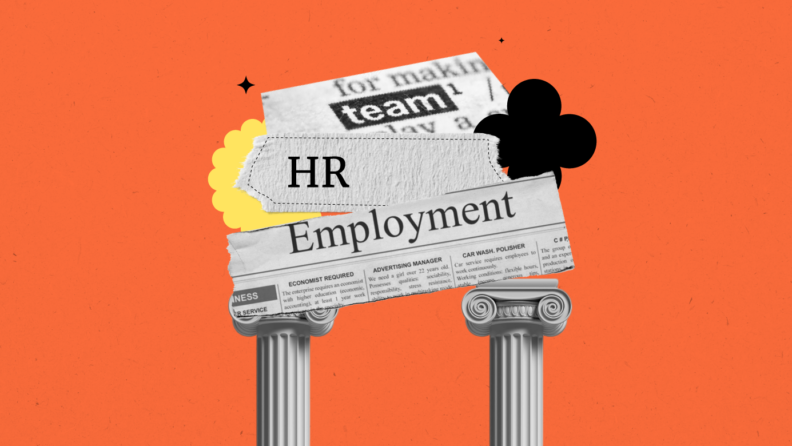The role of HR has evolved from being predominantly admin-focused to being an integral strategic partner of the business.
In light of this evolution, here I’ll examine the role of HR and the 7 key HR pillars that the function is built upon.
What is HR?
The HR department is responsible for a number of processes, such as recruitment and talent development, that help organizations achieve their goals through people and, increasingly, AI.
In practice, this means working closely with the business to help define goals, identify the actions and activities needed to meet goals, identify key metrics, and align talent to be successful.
Human resource professionals are also responsible for ensuring organizations remain compliant with labor laws in their respective territories.
7 HR Pillars
In light of the above, HR departments’ activities are centered around these 7 core pillars.
1. Workforce planning
Talent needs are constantly evolving and the goal of workforce planning is to ensure that an organization has the talent in place to achieve its goals.
During the workforce planning process, human resources will work with business leaders to identify talent needs and then develop strategies to meet them.
This will inform talent management strategies such as recruitment and learning and development.
2. Recruitment
A key pillar, recruitment covers helping the organization attract, find, assess, and onboard the talent needed to meet strategic goals.
Recruitment activities include:
- Helping define an employer value proposition and develop an employer brand.
- Recruitment marketing activities e.g. social media campaigns and career pages
- Writing job descriptions
- Candidate sourcing
- Candidate screening
- Interviewing and assessments
- Developing and presenting job offers
- Helping to onboard new hires
- Designing and collecting feedback about the recruitment process.
HR will manage the recruitment process from start to finish, collaborating with hiring managers and sometimes external professionals.
3. Learning and development
While dipping into the market is sometimes necessary, it’s often more beneficial to develop talent in-house.
Learning and development (L&D) covers activities such as:
- Designing training programs
- Facilitating mentoring and coaching initiatives
- Developing career development programs e.g. development plans, succession planning, and job rotations
- Fostering a culture of continuous development and feedback.
The effectiveness of the L&D strategy can be assessed through their impact on business outcomes such as revenue, cost, and risk as well as changes in behavior and skills gained.
4. Performance management
Closely tied to learning and development is performance management. This covers activities such as the somewhat dreaded annual performance review.
However, as Eric Grant points out in his excellent article, organizations should aspire to a continuous performance management process i.e. a system of ongoing, regular feedback that’s instructive, constructive, and celebratory.
Operationally, continuous performance management is characterized by more frequent performance reviews, regular check-ins, and a shift to shorter, more dynamic goals.
5. Compensation management
Remuneration is important for attracting and retaining the right talent. Aside from doing payroll, HR teams help organizations provide the right mix of monetary and non-monetary rewards to attract, retain, and motivate talent.
Here's what compensation management includes:
- Developing compensation philosophies to act as a framework for making compensation decisions around salaries, bonuses/commissions, equity, and benefits.
- Conducting a job-leveling exercise to determine roles based on their relative value in your organization.
- Market research and salary benchmarking to understand how competitive compensation packaged are vs peers.
- Establishing pay grades and ranges using the data from job analysis and market research.
6. Employee relations
The marmite of HR. Some professionals love it, others not so much.
Employee relations (ER) means balancing the wants and needs of the employer with those of the employees, both collectively as well as individually.
A human resources department adept at ER will foster a positive employment experience while protecting the company by maintaining compliance.
Needless to say, when people are involved, things can get jammy.
As Jessica Cieslinsky covers in her great article on improving employee relations, the secret to good employee relations is having systems and processes such as regular performance reviews and regular, transparent communication.
7. Compliance
Last but not least we have compliance. It’s not sexy, but it’s vital to the success of an organization.
HR compliance refers to an organization’s adherence to the laws, regulations, policies, and procedures that govern employment practices, the physical workplace, and the treatment of employees.
This covers various areas, including hiring practices, employee classifications, compensation and benefits, workplace safety, organizational policies, employee records management, and labor relations.
Compliance is important for several reasons, the most obvious being legal compliance, but also employee well-being and reputation as well.
If you do enough research, you'll be able to find an HR system that offers modules to support all 7 core pillars of HR. If you can't find one solution, integrating different HR systems you already have can provide you with a customized approach using software your people are already familiar with.
Next Steps
Hopefully this article has given you a flavor of how HR teams support business success. Consider taking a HR course to get more familiar with these concepts and subscribe to our weekly newsletter for HR and business leaders.
You'll receive all our latest content to help you grow in your career and make greater impact in your org.

